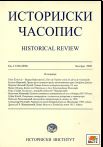Почеци Ногајеве власти у западној степи на доњем Дунаву (c. 1267-1273)
The Beginnings of Nogai`s Rule in the Western Steppes and in the Lower Danube (c. 1267-1273)
Author(s): Aleksandar UzelacSubject(s): History
Published by: Istorijski institut, Beograd
Keywords: Nogai; Mongke; Temur; Tatars; Ulus Juchi (Golden Horde); Byzantium; Bulgaria; Lower Danube
Summary/Abstract: Numerous works and historical papers are dedicated to the life and times of Nogai, famous descendant of Genghis-khan. However, many details from his biography either remain unanalyzed, or deserve to be put in the proper historical context. In this article attention is cast to one of these questions – beginnings of Nogai’s rule in the western parts of the Black sea steppes, his establishment in Dniester-Prut interfluve and spread of his sphere of influence to the region of the Lower Danube. Despite frequently repeated opinion Nogai wasn’t present, nor he was a leader of joint Tatar-Bulgarian attack on Byzantine Thrace in 1264/5. He established himself in the West only after the death of Berke and ascendance of his successor Möngke-Temür (1266). The chronological timeframe of this event can be further determined by Nogai’s first recorded activities in the region – it was his embassy sent to the Mamluk sultan Baybars al Bundukhdari in Muharram, 669. A.H. (August/September 1270). According to the analysis of three independent sources: Byzantine historian George Pachymeres, Persian writer Rashid al-Din Hamadani and Mamluk chronicler Baybars al-Mansuri it may be concluded that it ensued as part of the complex transfer policies conducted by Sarai elite under the leadership of Möngke-Temür, aimed at strengthening Tatar presence in the West. Himself a convertite to Islam, and although not its ardent proponent, Nogai enjoyed the support of “pro-islamic” faction among Juchids, whose prominent member was Chichek-khatun, wife of Berke and Möngke-Temür. Probably during the reign of Möngke-Temür, Nogai’s status was further determined by his elevation to the high position of the commander of the right hand, i.e. leader of the western parts of Juchid lands. Early years of Nogai’s rule in the Western steppes were marked by hostile and aggressive moves towards neighboring Hungary (1270–1271) and Byzantium (c.1272). However, new Tatar incursions into the Central and Southeast Europe didn’t ensue as а consequence of Nogai’s independent actions; they were directed from Sarai and they represented the continuation of the policies of Berke. Even his correspondence with Baibars couldn’t beinterpreted as his desire towards independence. The diplomatic move was indeed prompted by Nogai, but also by other influential leaders in the Western steppes – Tok-Buka and Uran-Temur, who were subjected to Möngke Temür. Only after the Tatar attack on Byzantium, Nogai’s role changed. In c. 1273. he made an agreement with the emperor Michael VIII Paleologus and took as his bride the princess Eyphrosyne.
Journal: Историјски часопис
- Issue Year: 2013
- Issue No: 62
- Page Range: 11-34
- Page Count: 24
- Language: Serbian

